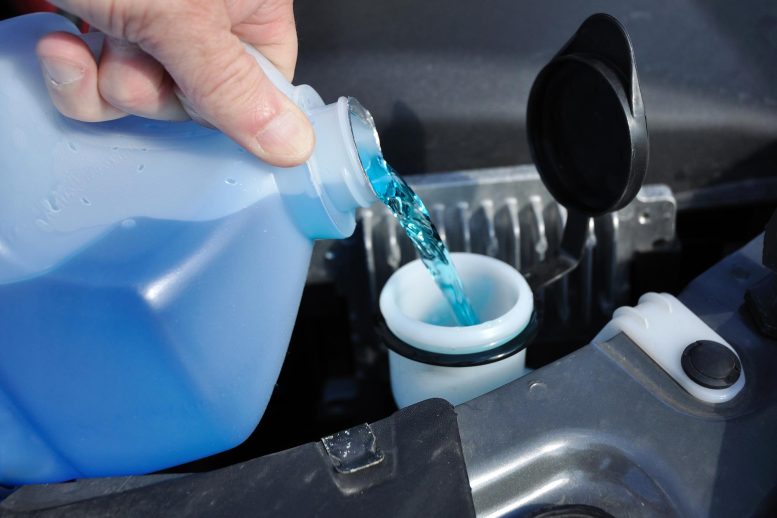
In a study published in the ACS’ Environmental Science & Technology journal, researchers reported that windshield washer fluid alcohols represent a higher fraction of vehicle emissions than previously estimated. This source of pollution remains constant even as more drivers switch from gas to electric vehicles.
A research study reveals that alcohols from windshield washer fluid contribute more significantly to vehicle emissions than previously thought. This holds true even with the increased adoption of electric vehicles, suggesting the need for future regulatory policies to address such non-fuel-derived pollutants.
Exhaust fumes probably come to mind when considering vehicle emissions, but they aren’t the only source of pollutants released by a daily commute. In a recent ACS’ Environmental Science & Technology study, researchers report that alcohols in windshield washer fluid account for a larger fraction of real-world vehicle emissions than previous estimates have suggested. Notably, the levels of these non-fuel-derived gases will likely remain unchanged, even as more drivers transition from gas-powered to electric vehicles.
Cars’ average carbon dioxide emissions have dropped by 25% since the early 2000s, according to the U.S. Environmental Protection Agency, but this gas only accounts for part of the total. Another important component of emissions is volatile organic compounds (VOCs), a broad classification of carbon-based molecules that are easily vaporized and that can contribute to ozone formation. While some VOCs are released in exhaust, others may arise from an unexpected source – the products used for “car care,” such as windshield washer fluid. Estimates from a national inventory of manufacturer statistics in the U.K. showed that car-care products could be an even greater source of VOCs than exhaust, but these numbers had never been verified experimentally. So, Samuel Cliff and coworkers decided to measure the amounts of vaporized windshield washer fluid ingredients from cars on a real-world road and compare it to the inventory estimates.
To measure the VOCs actually emitted by vehicles, the researchers outfitted a van with several instruments, including a mass spectrometer, and parked it near a busy roadway. By comparing the van’s measurements with those from a university site with minimal traffic influence, they calculated the average amount of vapor given off per car for each kilometer traveled for several key VOCs.
The measured values matched inventory estimates for aromatic compounds that are commonly monitored and regulated, but those for alcohols – key ingredients in windshield washer fluid – far exceeded inventory numbers. In fact, the release of two alcohols, ethanol, and methanol, was nearly twice the amount of all VOCs released in exhaust. The discrepancy in alcohol emissions could be accounted for by including solvents from car-care products in the inventory estimations, suggesting that these products are a significant, if unexpected, source of vehicle-derived pollutants. The researchers say that this finding has implications for future regulatory policy, especially as drivers transition to electric vehicles, which may have fewer emissions from fuels but will still need clean windshields.
Reference: “Unreported VOC Emissions from Road Transport Including from Electric Vehicles” by Samuel J. Cliff, Alastair C. Lewis, Marvin D. Shaw, James D. Lee, Michael Flynn, Stephen J. Andrews, James R. Hopkins, Ruth M. Purvis and Amber M. Yeoman, 16 May 2023, Environmental Science & Technology.
DOI: 10.1021/acs.est.3c00845
The authors acknowledge funding from the U.K. Natural Environment Research Council and the Panorama Natural Environment Research Council Doctoral Training Partnership.









Give me a damn break for cryin’ out loud
Some all-purpose cleaner mixed with a lot of water will do just fine for any day but winter.
So alcohol is causing global warming? Guess Bud Light was think about the environment
Does this mean all alcohol needs to be done away with? Would not the air around an university have higher alcohol levels from all the traffic?
I find it interesting how they determined the alcohol is the problem even though all the plastic in vehicles also off gas as well. But that’s already discussed and didn’t stop anyone from moving away from gas vehicles. You “scientists” better start looking into carbon fiber and it’s VOC. To bad no environmentalist is brave enough to go to china or India and preach there.
Give me a break. You want to look into emissions, look into golf cart communities in Florida, where there are literally more than 100k golf carts in just one area. No one bothers to test the air quality of those places.
“contribute to ozone formation.”. ?
Just more propaganda trying to get people to give up cars and depend completely on government transportation. They never stop.
You can literally just use Vodka….
Electric motors and charging stations emit ground Ozone which is a pollutant and also harmful to plants. Unlike CO2, which plants need to grow.
Julian is right,
use Vodka! Let 4 southern boy red necks start drinkin Vodka, then pair up,& itll be on!! I guarantee two of em can push & steer faster than other two
I thought commenters like those represented here should get a job, and then I wondered why goofs like these might even be reading a science article of this nature. I concluded that they were volunteers or employees of the world-wrecking political polluters, the fossil fuel big-money gang.
All the problems there are now, you look for things to complain about. B.S.
I noticed they didn’t actually quantify the emissions in question, just said double the amount expected. My guess is that they are still infinitesimal compared to the real problems that require our attention. Otherwise, they would have given the really large numbers…
Like the garbage in the oceans, but we will worry about the window washer fluid. Oh, and Chinese overfishing. Fleets of ships with gigantic nets, raping the oceans. But but alcohol in window washer fluid.
I was going to say give me a break but I see several people have beaten me to that.
Stop alcohol production maybe?
Well, if the government puts its nose too deep, it’s time to change the government.
Time to? past time to,
again.
I’ve seen stupid but this is just beyond stupid. Talk about grasping at straws. This crap is exactly why ppl don’t listen to this at all. Anyway who am I? I took off all that garbage on my 21 ram 2500 Cummins and roal coal everyday
Ok cool deal question when the EPA finds out that people admit foreign in harmful items into the ear by breathing are they going to cut off their ear cut out their lungs put on a special respirator for their face so they don’t admit anything come on people let’s pull the s*** out of your ass and then wipe it all over your face cuz that’s the real s*** heads that you are there you go have a good day now knuckleheads
This is beyond ridiculous. What’s next? Human beings passing gas are a major contributer to global warming? I am so over this. The one thing that stood out is that vehicle emissions have dropped 25% in 20 years. Yeah, they let that one slip. This are getting better without EVs.
Rather than using elaborate measurement equipment, it would have been easier to determine the alcohol or voc content of the washer fluid and assume it was all evaporated. This method is used for paints and inks. Interesting study if washer fluid emissions and exceed tailpipe emissions. Important information if prioritizing options to reduce ozone pollution.
It would be far more effective than tests capturing unburned ethanol from the exhaust emissions.